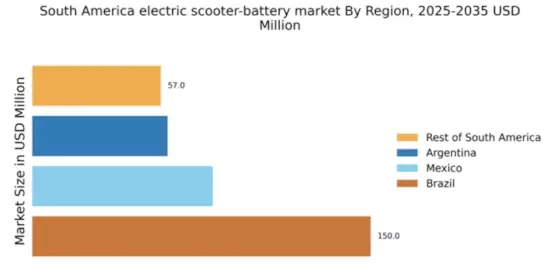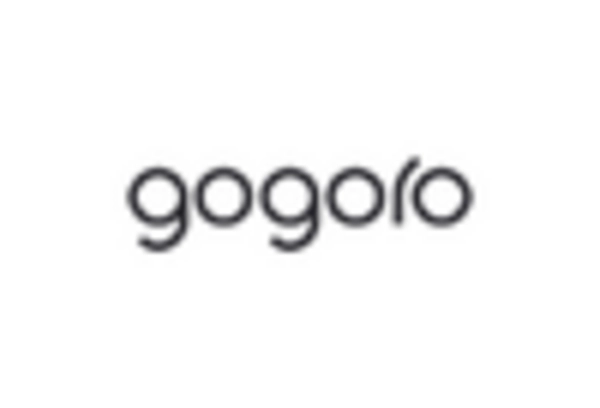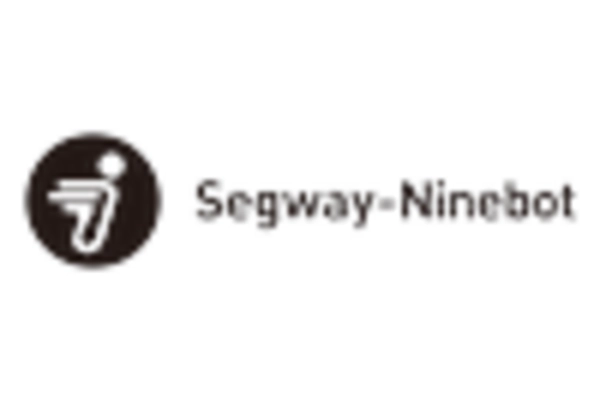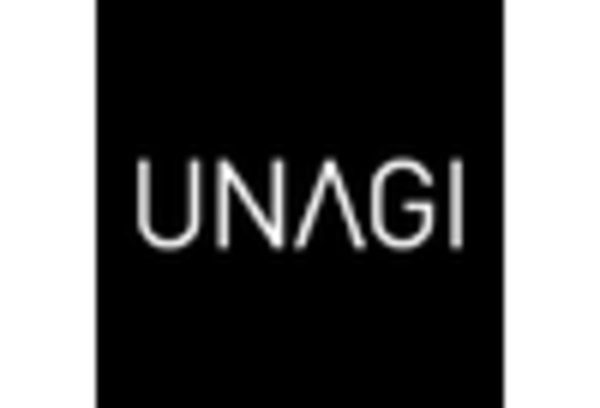Urbanization and Mobility Needs
The rapid urbanization in South America is driving the electric scooter-battery market. As cities expand, the demand for efficient and sustainable transportation solutions increases. Urban areas face congestion and pollution challenges, prompting consumers to seek alternatives to traditional vehicles. Electric scooters, powered by advanced battery systems, offer a practical solution for short-distance travel. In 2025, urban populations in South America are projected to reach approximately 80% of the total population, further intensifying the need for eco-friendly transportation options. This trend indicates a growing market for electric scooters, which rely heavily on reliable battery technology to meet consumer expectations for performance and range. Consequently, the electric scooter-battery market is likely to experience significant growth as urban mobility needs evolve.
Cost-Effectiveness of Electric Scooters
The economic advantages of electric scooters are becoming increasingly apparent in South America, contributing to the growth of the electric scooter-battery market. With rising fuel prices and maintenance costs associated with traditional vehicles, consumers are turning to electric scooters as a cost-effective alternative. The total cost of ownership for electric scooters is often lower, as they require less maintenance and have lower operational costs. In 2025, the average cost of operating an electric scooter is estimated to be around $0.02 per km, compared to $0.10 per km for gasoline-powered vehicles. This financial incentive encourages more individuals to adopt electric scooters, thereby boosting demand for high-quality battery systems that can support longer ranges and faster charging times. As a result, the electric scooter-battery market is poised for expansion.
Environmental Awareness and Regulations
Increasing environmental awareness among consumers in South America is significantly impacting the electric scooter-battery market. As concerns about climate change and air quality rise, individuals are more inclined to choose sustainable transportation options. Governments are also implementing stricter regulations to reduce emissions, which further promotes the adoption of electric scooters. In 2025, several South American countries are expected to introduce incentives for electric vehicle purchases, including electric scooters, which may include tax breaks or subsidies. This regulatory support is likely to enhance the attractiveness of electric scooters, leading to a surge in demand for efficient battery systems that comply with environmental standards. Consequently, the electric scooter-battery market is likely to benefit from this growing trend.
Technological Innovations in Battery Efficiency
Technological advancements in battery efficiency are playing a crucial role in shaping the electric scooter-battery market in South America. Innovations such as lithium-ion and solid-state batteries are enhancing the performance and longevity of electric scooters. These advancements allow for longer ranges and shorter charging times, addressing one of the primary concerns of potential users. In 2025, the average range of electric scooters is expected to exceed 60 km on a single charge, thanks to these improvements. As battery technology continues to evolve, manufacturers are likely to invest in research and development to create even more efficient solutions. This focus on innovation is expected to drive the electric scooter-battery market forward, attracting more consumers to adopt electric scooters as a viable mode of transportation.
Infrastructure Development for Electric Mobility
The development of infrastructure to support electric mobility is a key driver for the electric scooter-battery market in South America. As cities recognize the need for sustainable transportation solutions, investments in charging stations and dedicated lanes for electric scooters are increasing. By 2025, it is anticipated that the number of charging stations in major South American cities will grow by over 50%, facilitating easier access for electric scooter users. This infrastructure development not only enhances the convenience of using electric scooters but also encourages more individuals to consider them as a primary mode of transport. The availability of reliable charging options is likely to boost consumer confidence in electric scooters, thereby propelling the electric scooter-battery market to new heights.


















Leave a Comment